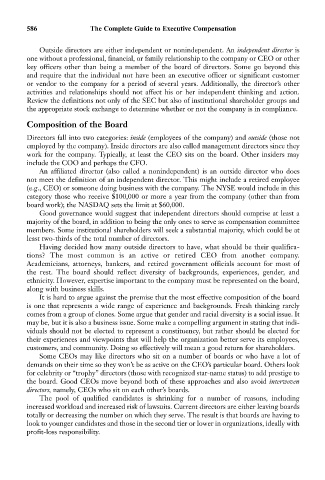Page 600 - Bruce Ellig - The Complete Guide to Executive Compensation (2007)
P. 600
586 The Complete Guide to Executive Compensation
Outside directors are either independent or nonindependent. An independent director is
one without a professional, financial, or family relationship to the company or CEO or other
key officers other than being a member of the board of directors. Some go beyond this
and require that the individual not have been an executive officer or significant customer
or vendor to the company for a period of several years. Additionally, the director’s other
activities and relationships should not affect his or her independent thinking and action.
Review the definitions not only of the SEC but also of institutional shareholder groups and
the appropriate stock exchange to determine whether or not the company is in compliance.
Composition of the Board
Directors fall into two categories: inside (employees of the company) and outside (those not
employed by the company). Inside directors are also called management directors since they
work for the company. Typically, at least the CEO sits on the board. Other insiders may
include the COO and perhaps the CFO.
An affiliated director (also called a nonindependent) is an outside director who does
not meet the definition of an independent director. This might include a retired employee
(e.g., CEO) or someone doing business with the company. The NYSE would include in this
category those who receive $100,000 or more a year from the company (other than from
board work); the NASDAQ sets the limit at $60,000.
Good governance would suggest that independent directors should comprise at least a
majority of the board, in addition to being the only ones to serve as compensation committee
members. Some institutional shareholders will seek a substantial majority, which could be at
least two-thirds of the total number of directors.
Having decided how many outside directors to have, what should be their qualifica-
tions? The most common is an active or retired CEO from another company.
Academicians, attorneys, bankers, and retired government officials account for most of
the rest. The board should reflect diversity of backgrounds, experiences, gender, and
ethnicity. However, expertise important to the company must be represented on the board,
along with business skills.
It is hard to argue against the premise that the most effective composition of the board
is one that represents a wide range of experience and backgrounds. Fresh thinking rarely
comes from a group of clones. Some argue that gender and racial diversity is a social issue. It
may be, but it is also a business issue. Some make a compelling argument in stating that indi-
viduals should not be elected to represent a constituency, but rather should be elected for
their experiences and viewpoints that will help the organization better serve its employees,
customers, and community. Doing so effectively will mean a good return for shareholders.
Some CEOs may like directors who sit on a number of boards or who have a lot of
demands on their time so they won’t be as active on the CEO’s particular board. Others look
for celebrity or “trophy” directors (those with recognized star-name status) to add prestige to
the board. Good CEOs move beyond both of these approaches and also avoid interwoven
directors, namely, CEOs who sit on each other’s boards.
The pool of qualified candidates is shrinking for a number of reasons, including
increased workload and increased risk of lawsuits. Current directors are either leaving boards
totally or decreasing the number on which they serve. The result is that boards are having to
look to younger candidates and those in the second tier or lower in organizations, ideally with
profit-loss responsibility.

